2012 Issyk Kul Expedition: Search for a Sunken Palace
Kristin Romey
Source - http://newswatch.nationalgeographic.com/2012/09/06/2012-issyk-kul-expedition-search-for-a-sunken-palace/
After a year of careful planning, our National Geographic team is now set up at a base camp on the northern shore of Issyk Kul, one of the world’s highest and deepest lakes, in the Central Asian republic of Kyrgyzstan.
So why are we here? Issyk Kul, which means “hot lake” in Kyrgyz, was a critical location along the fabled Silk Road, with routes running along its shores. Nestled in the largest east-west valley in the high Central Asian mountains, Issyk Kul was renowned in historical documents as a strategic point along the Silk Road that was vied and battled for over the millennia. Countless traders, caravans and nomadic tribes and armies traveled along the 113-mile long lake, leaving a remarkable archaeological legacy behind.

A map of the Silk Road, with Issyk Kul located in the top center of the map. Map courtesy Fred Hiebert.
Since the nineteenth century, Russian scientists and, subsequently, Soviet archaeologists and researchers from the Kyrgyz Academy of Sciences have studied the ancient remains around Issyk Kul, which range from petroglyphs and 3,000-year-old kurgans (nomadic burial mounds) to early Christian monasteries and medieval cities.
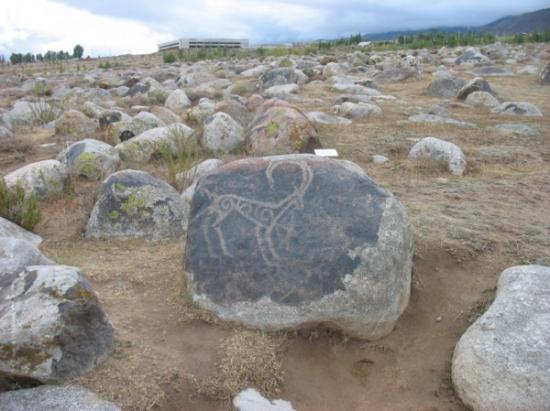
Zoomorphic petroglyphs (ca. 1500 BC) near Issyk Kul. Photo courtesy Fred Hiebert.
Early on, Issyk Kul also drew attention from researchers for the remains that lie beneath its stunning cobalt waters. It’s an endorheic lake (meaning that it has no outlet) with abundant underwater springs, and the water level has fluctuated dramatically over the centuries, submerging settlements, buildings and even entire cities that had been established on earlier shorelines. Issyk Kul was one of the earliest sites for underwater archaeological research in Central Asia, with divers exploring its depths as long ago as the 1860s.
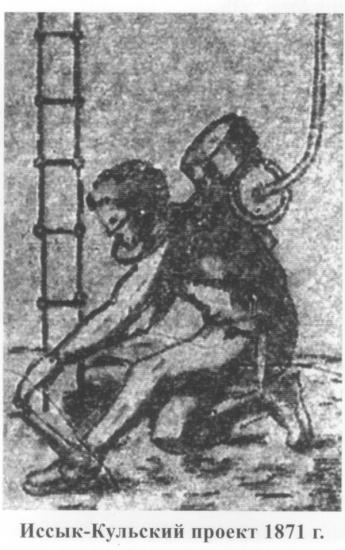
A 19th-century diver in Issyk Kul. Photo from Vinnik 1959.
In the Middle Ages, the region around the lake was hotly contested by two divergent lines of descendants from Genghis Khan: nomadic, shamanistic Eastern Mongols and the city-dwelling, Islamic Western Mongols. The legendary Western Mongol leader Tamerlane (Timur, 1336-1405) was said to have battled for the lake region in the early 1400s, and there are medieval accounts of palace built by the conqueror on the northern shore of Issyk Kul.
This rumored building has been one of the most frequently cited phenomena in the lake, and a site associated with it was first investigated by a Russian historian, G.A. Kolpakovsky in 1869. A few decades later, the historian V.V. Bartold theorized that the site was associated with the 15thcentury palace as described by the medieval Arab historian Ibn Arab Sheikh.
The existence of such a building is of major historical importance, as it would document a critical expansion of Tamerlane’s empire, and the possibility exists that the building was constructed in the style of the Timurid state buildings at Samarkand and Shakhrisabz, as well as the Taj Mahal. If this is indeed a newly discovered Timurid monumental building, it would be a very significant addition to the catalogue of Islamic architecture.
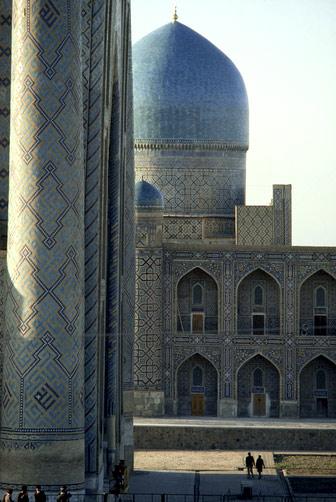
Sky-blue tiles on a Samarkand mosque preserve the ancient tradition. Photo by Gordon Gahan.
Since Bartold first presented his theory that there may indeed be a monumental building associated with Tamerlane in Issyk Kul, archaeologists and historians have repeatedly returned to the site, located near the town of Cholpon-Ata.
In 1926-27 the archaeologist P.P. Ivanov carefully studied the underwater ruins in and made a map, “so that future researchers could not spend too much time searching for their interest.” His work however, was never published and only came to light only in 1957.
In 1959, Dmitri Vinnick of the Kyrgyz Institute of History returned to the question of the nature of the remains and began systematic archaeological survey of the site. He reported regular walls made of brick, wooden beams and blue-glazed tiles of a Timurid type, but ironically, due to Soviet political repression of “Central Asian” history–i.e., finding evidence of Tamerlane’s (a Muslim) conquest of the region–his work was not followed up and he was not allowed to publish on this important finding.
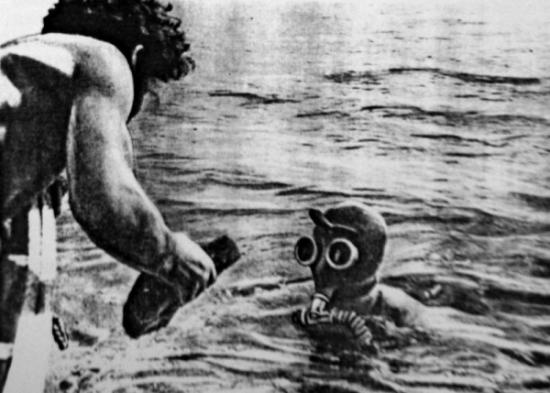
A diver on the 1959 Vinnik expedition to Issyk Kul. Photo from Vinnik 1959.
Since 1985, Professor Vladimir Ploskikh, vice-president of the Kyrgyz Academy of Sciences, has been conducting underwater surveys and excavations in Issyk Kul, and beginning in 2010 we have partnered with him to explore the history of this fascinating lake, and to finally resolve the question of whether there is truly a legacy of one of the world’s most legendary conquerors beneath its waters.
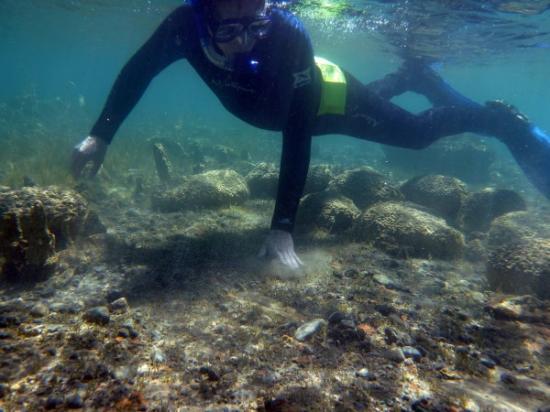
National Geographic Archaeology Fellow Fredrik Hiebert at work in Issyk Kul; Photo courtesy Brad Vest/National Geographic.
Last year, a small National Geographic team conducted a visual and remote sensing survey of the site, and what we found compelled us to stage a full-scale examination this year. Armed with a toolkit of high-tech remote sensing equipment, along with traditional exploration, diving and underwater excavation, we’ll be spending a month on this beautiful, mountain-ringed lake, and we’ll introduce you to our team and share updates with you on our progress, as well as information on the fascinating history of Issyk Kul and an insider’s look at how an underwater archaeological expedition on one of the world’s highest lakes gets done. Feel free to ask questions in the comments, and stay tuned for our discoveries!